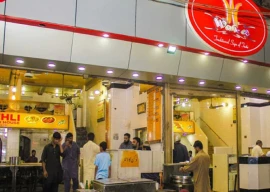
While Ramazan on one hand is about abstinence and observing moderation, it is also a month of celebration for the food lovers. Karachi, alone, is home to a number of different communities that not only delve in the customary pakoray, chaat, samosay and dahi baray but also relish their traditional dishes.
Memons
While they are classified into different categories as the Bantva, Jaipur, Gujrati and Kutchi Memons among others, one thing that all Memons share is their zest for food.

Phirki. PHOTO: COURTESY SAIMA
For Bantva Memons, Sehr includes delicacies such as vermicelli, nihari and liver. Iftar, on the other hand, is nothing less than a feast where an item eaten in a bowl, be it chaat or chickpeas, is a must. This item is referred to as a 'pyali wala item' [bowl item].
Talking about 'Mal Puras', Institute of Business Administration student Saman Dada, who is a Bantva Memon, shared that the community has these pancakes glazed with honey for those who just can't ignore their sweet tooth in Ramazan.
'Box patties' are yet another delicacy common among Memons. While the wraps of these patties may be similar to those of spring rolls and samosas, it is the filling of chicken, spring onions, white sauce and mayonnaise that makes them a clear winner. Popular among a majority of Memon households, box patties are a regular appearance at their Iftar settings.
'Bajray ke kebab', a form of pakoray-cum-kebab, is a mouth-watering dish made of minced meat marinated with onions, green chillies, cumin seeds and other spices. Millet flour, locally known as bajra, is then folded into the meat.

Lagaan Seekh. PHOTO: FILE
The mixture is used to shape small balls and fried. Javeria Rahim, a Kutchi Memon, talked about how the recipe has been picked up by local cooking shows. "You can see every other chef teaching their audiences how to make these kebabs these days," she said.
Hazaras
Saima Batool, a Hazara resident of North Nazimabad, described 'Phirki' as a dish inspired by Hazara tradition. Phirki - a Bolani word - is a combination of spinach and a wrap made of flour. Spinach and potatoes are boiled, seasoned with spices for flavour. Round rotis are spread with a rolling pin and the spinach and potato filling is stuffed in the middle to make D-shaped flat parathas, which are then fried. Other than this, dinner meals of Hazaras are based on shorbay walay salan [gravies] of goat or chicken, which are consumed with naans.
Bohras
The Dawoodi Bohra community is known for its rich and esteemed Gujrati traditions. Hailing from Indian Gujrat, they not only speak Gujrati but their cuisine is heavily inspired by the culture. With their food served as elaborate presentations in thaals [large round trays] at all their gatherings, their Iftar snacks are a feast fit for the king.
A famous delicacy of their cuisine is 'patarveliya', locally known as arbi leaves. These leaves are laden with spices and steamed. The preparation includes washing the leaves, followed by a smear of a thick coating of a mixture made of gram flour and spices. The leaves are then rolled in sushi style and secured by winding strings around them. Steamed on very low heat, they are then fried with minced meat.

Arbi leaves. PHOTO: COURTESY SAKINA NANABHAI
Talking about 'lagaan seekh', Bohri student Sakina Nanabhai described it as a dish made by her mother in Ramazan exclusively. "It's a simple dish in which vegetables and minced meat are topped with beaten eggs to coat everything nicely," she explained. "The dish is put in the oven for slow cooking whereupon the eggs bind everything together to make a thick layer. It is then easily scooped out of the pan and eaten with roti and condiments or just as it is."
Another luxury offered by the community is 'Khaman' or 'Dhokri', which is a spongy yellow cake made of gram flour that is steamed until fully cooked. Later, it is seasoned with curry leaves and mustard seeds.
Published in The Express Tribune, July 4th, 2015.



1725030039-0/Untitled-design-(2)1725030039-0-165x106.webp)
1725366721-0/kyle-(1)1725366721-0-165x106.webp)


1725446940-0/Untitled-design-(16)1725446940-0-270x192.webp)









COMMENTS
Comments are moderated and generally will be posted if they are on-topic and not abusive.
For more information, please see our Comments FAQ